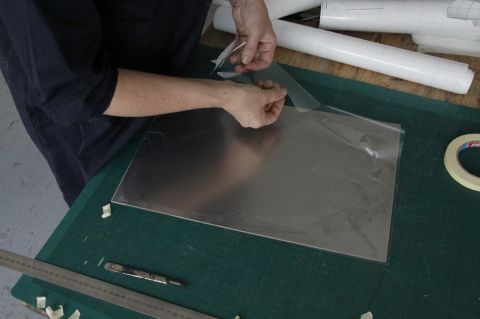Tracing, Cutting and Sticking.
Tracing the image from the screen and cutting it with a scalpel into the sticky-backed-plastic involves a surprising amount of drawing. Small decisions are made at each stage. How sharp should that corner be? How should I enterpret that fuzzy bit of the photograph? There is a style even to traced drawings and more so to the drawing with the scalpel that I have to do as I slice through the plastic. I have never drawn with a scalpel before. It is rather satisfying and I begin to get more skillfull at it. It seems an appropriate way of drawing the shapes made by sharp glassy edges.
With practise I improve at the fiddly business of cutting and getting the plastic on to the plate. After a while I am in a zone of tracing, turning , cutting and sticking, but after a longer while , I begin to get bored and very tired and to lose concentration. I realise there are a great variety of possible mistakes to make. With all this repetition I have many oportunities to make all of them. For example: Placing the tracing paper or cutting the plastic upside down, both result in the printed image being back-to-front. Sticking the wrong part of the plastic on the plate results in black where there should be white. Spraying the front of the plate instead of the reverse with stop out enamel is just stupid, but somehow I do manage to do that once.
Can these mistakes be accepted as part of the process? When I notice my mistakes early I re-cut the plastic, but 4 plates get bitten and printed before I realise the image is back-to-front. I don’t have time to redraw and re-etch new plates so I have to accept all but one of them. In that one, the change in compostion caused by the reversal of the image, upsets me too much and I crack and have to redo it.





